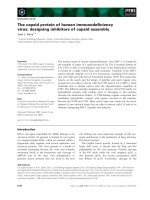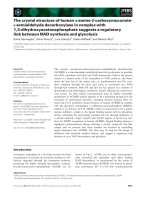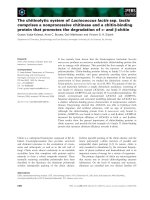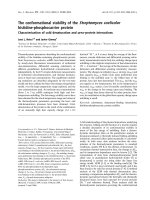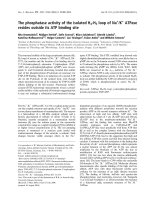Báo cáo khoa học: The signature amidase from Sulfolobus solfataricus belongs to the CX3C subgroup of enzymes cleaving both amides and nitriles Ser195 and Cys145 are predicted to be the active site nucleophiles pot
Bạn đang xem bản rút gọn của tài liệu. Xem và tải ngay bản đầy đủ của tài liệu tại đây (1.63 MB, 9 trang )
The signature amidase from Sulfolobus solfataricus
belongs to the CX
3
C subgroup of enzymes cleaving both
amides and nitriles
Ser195 and Cys145 are predicted to be the active site nucleophiles
Elisa Cilia
1,2
, Armando Fabbri
1
, Monica Uriani
1
, Giuseppe G. Scialdone
1
and Sergio Ammendola
1,2
1 Centre of Biotechnology-Bioprogress, Anagni, Italy
2 AMBIOTEC SAS SS7, Cisterna di Latina, Italy
Amide hydrolase (AH) and nitrilase (Nit) are two
superfamilies of enzymes cleaving C–N bonds of differ-
ent substrates [1]. These proteins all share the typical
a ⁄ b hydrolase fold and can be grouped on the basis of
their catalytic site and preferred substrate [2,3]. The
enzymes of the Nit superfamily have a catalytic site
formed by a Glu–Cys–Lys triad and can hydrolyse
nitriles (EC 3.5.1.1) or the carboxylic amide group
(EC 3.5.1.4) [4].
The AH superfamily includes the signature amidases,
originally identified by primary structure analysis [5].
The substrate specificities and biological functions of
these enzymes vary widely, but it has been shown that
they all have a similar catalytic mechanism mediated
by a Ser–cisSer–Lys catalytic triad [6–8].
Recently, the gene coding for the signature amidase
from Sulfolobus solfataricus (SsAH) has been expressed
in Escherichia coli and characterized [9]. This is a wide
spectrum AH, converting carboxylic amides to their
corresponding organic acids. We report that the SsAH
enzyme also possesses nitrilase activity, a property
shared by the well-characterized signature amidase
from Rhodococcus rhodochrous J1 (RhorhJ1) [10,11].
Both enzymes contain an additional CX
3
C motif.
To understand the structural basis of this dual spe-
cificity, we constructed random mutants of SsAH and
screened them for their activity on amide, nitrile and
ester substrates. Mutants showing increased activity on
nitriles all carried the Lys96Arg substitution, an obser-
vation confirmed by site-directed mutagenesis.
The structural framework of the observed mutations
was investigated by constructing a homology model of
the enzyme. The model suggests that a putative addi-
tional catalytic triad formed by Ser171–Cys145–Lys96,
where position 145 corresponds to the second cysteine
of the additional CX
3
C motif, exists in this enzyme.
We suggest that this alternative active site is respon-
sible for the hydrolysis of nitriles, with Cys145 acting
Keywords
amidase; catalytic triad; CX
3
C; modelling;
mutagenesis
Correspondence
S. Ammendola, Via Paduni 240-03012
Anagni FR, Italy
Fax: +39 077 576 6541
Tel: +39 077 576 6824
E-mail:
(Received 14 June 2005, revised 18 July
2005, accepted 28 July 2005)
doi:10.1111/j.1742-4658.2005.04887.x
The signature amidase from the extremophile archeum Sulfolobus solfatari-
cus is an enantioselective enzyme that cleaves S-amides. We report here that
this enzyme also converts nitriles in the corresponding organic acid, simi-
larly to the well characterized amidase from Rhodococcus rhodochrous J1.
The archaeal and rhodococcal enzymes belong to the signature amidases
and contain the typical serine-glycine rich motif. They work at different
optimal temperature, share a high sequence similarity and both contain an
additional CX
3
C motif. To explain their dual specificity, we built a 3D
model of the structure of the S. solfataricus enzyme, which suggests that, in
addition to the classical catalytic Ser-cisSer-Lys, a putative additional
Cys-cisSer-Lys catalytic site, likely to be responsible for nitrile hydrolysis, is
present in these proteins. The results of random and site-directed muta-
genesis experiments, as well as inhibition studies support our hypothesis.
Abbreviations
AH, amide hydrolase; Nit, nitrilase; RhorhJ1, Rhodococcus rhodochrous J1; SH, serine hydrolase; Ss, Sulfolobus solfataricus; WT, wild type.
4716 FEBS Journal 272 (2005) 4716–4724 ª 2005 FEBS
as the nucleophile involved into the thiol-mediated
catalysis of nitriles.
Sequence analysis suggests that other signature
amidases, containing the additional CX
3
C motif, con-
stitute a subgroup of the family and might all be able
to cleave both amides and nitriles.
Results
Recently, the recombinant wild-type gene coding for
the signature SsAH protein (SsAH-WT) has been
cloned in E. coli and its product characterized. The
enzyme exhibits high thermostability and thermophilic-
ity [9]. The archeal enzyme converts several amide sub-
strates in their corresponding organic acids producing
stoichiometric amounts of NH
3
(data not shown).
Consistent with previously published data, our prepar-
ation of the purified recombinant SsAH-WT remains
active at 70 °C for about 6 days and has a half-life of
5 h at 95 °C (data not shown).
We found that SsAH-WT is able to convert both
amides and nitriles, and in particular benzonitrile
(Table 1). The specific activity of the enzyme on the
Benzonitrile substrate is about 1 ⁄ 2000 with respect
to its activity on benzamide (6 · 10
)4
lmolÆmin
)1
Æ
mg
)1
and 1.18 lmolÆminÆ
)1
mg
)1
, respectively). This is
similar to the observations for RhorhJ1, where
the ratio between the two activities is about 1 ⁄ 6000
[11].
A sequence alignment of signature AHs, shown in
Fig. 1, highlights blocks of structurally conserved resi-
dues. These include the strictly conserved GSSXG
motif. The first serine in this motif (Ser171 using SsAH
numbering) forms the catalytic triad, together with
Lys96 and Ser195 [12]. The second pattern,
Cys141X
3
Cys145, is conserved only in a limited num-
Table 1. Kinetic parameters of SsAH-WT and SsAH-K96R on different substrates. na, activity undetectable.
Structure Substrate
SsAH-WT SsAH-K96R
K
M
(lmol) k
cat
s
)1
K
M
(lmol) k
cat
s
)1
Isobutyramide
a
0.099 175 0.2 160
Propionamide
a
0.102 181 0.093 160
Benzamide
b
0.674 1192 0.723 1246
Cinnamamide
b
0.434 769 0.526 906
Malononitrile
b
0.0795 · 10
)3
0.140 0.609 · 10
)3
1.05
Tricloroacetonitrile
a
0.5 · 10
)6
0.010 0.130 · 10
)3
0.225
Benzonitrile
b
0.005 0.088 0.006
Phenylglycinenitrile 0.024 · 10
)3
0.043 9 · 10
)6
0.016
Cinnamonitrile
a
na na 9.607 · 10
)6
0.016
3-Anilinoproprionitrile
a
0.157 · 10
)3
0.279 0.103 · 10
)3
0.177
a
Assays were carried at pH 7.4 and T ¼ 70 °C using 61 lg purified protein. Activity was measured with the Berthelot assay, by reading the
absorbance of the colour developed at k ¼ 630 nm.
b
Benzamide and benzonitrile values were determined by HPLC.
E. Cilia et al. CX
3
C signature amidases can hydrolyze nitriles
FEBS Journal 272 (2005) 4716–4724 ª 2005 FEBS 4717
ber of signature AHs, including RhorhJ1-AH and
SsAH, both able to cleave nitriles (Fig. 2).
We built a comparative model of SsAH using the
program modeller with default parameters. In the
model (Fig. 3) the Ser171–cisSer195–Lys96 triad is
correctly positioned to perform catalysis with the Oc
atom of Ser171 at about 2.8 A
˚
from the Oc atom of
Ser195 and about 2.7 A
˚
from the amino group of
Lys96.
The analysis of the structural model reveals that
Cys145, present both in SsAH and in RhorhJ1-AH, is
in an ideal position to function as primary nucleophile
in a second catalytic triad (Cys145–Ser171–Lys96) that
could be responsible for the hydrolysis of nitriles.
Indeed, the sulfur atom of Cys145 is at about 3 A
˚
from the Oc atom of Ser171 and 2.5 A
˚
from the amino
group of Lys96 (Fig. 4). This putative alternative triad
is located in a different plane from the active site
Fig. 1. Multiple sequence alignment of signature AHs. The alignment was manually optimized taking into account the predicted or observed
secondary structure also shown. Shaded regions indicate alpha helices (lighter) and beta strands (darker). The conserved GXSXG motif is
underlined; identical residues (black triangles) represent the SsAH putative catalytic triad Ser171–cisSer195–Lys96. Black dots indicate the
cysteine residues of the CX
3
C motif. RhorhJ1, Rhodococcus rhodochrous J1; PAM, peptide amide hydrolase; MaE2, malonamidase; FAAH,
fatty acid amide hydrolase.
CX
3
C signature amidases can hydrolyze nitriles E. Cilia et al.
4718 FEBS Journal 272 (2005) 4716–4724 ª 2005 FEBS
catalytic triad and forms an angle of about 107° with
its plane (Fig. 5A).
Homology models can be useful to suggest functional
hypothesis especially when they are based on a convin-
cing evolutionary relationship, as in this case. Neverthe-
less their conclusions need to be experimentally verified.
In order to validate our hypothesis, we screened the
activity of more than 40 SsAH mutants. The mutants
were obtained by random, PCR-mediated mutagenesis
and their activity assayed with the colorimetric method
of Berthelot, appropriately modified for the assay con-
ditions of the archaeal enzyme. This assay is based on
the measurement of the colour that develops upon
ammonia production in the reaction. Ammonia is pro-
duced, in stoichiometrical amounts, upon substrate
hydrolysis.
Eight of the 40 mutants could hydrolyse most nit-
riles more efficiently than SsAH-WT. The only amino
acid substitution shared by all these mutants was the
K96R mutation. To investigate the role of this muta-
tion, we constructed the SsAH-K96R single mutant by
site-directed mutagenesis. The 310-nucleotide fragment
of the gene encoding SsAH was cut and used as tem-
plate to introduce, by PCR, the mutation K96R. After
amplification the fragment was purified and subcloned
into pET3d vector and DNA sequenced for confirma-
tion. The resulting plasmid was used to transform
E. coli BL21(DE3) cells and the enzyme was expressed
by isopropyl thio-b-d-galactoside (IPTG) induction as
for the wild-type enzyme. Both SsAH-WT and SsAH-
K96R were purified in a similar way and an identical
protein concentration was used to compare their nitri-
lase activity. The SsAH-K96R retains the ability to
hydrolyse amides but hydrolyses nitriles more effi-
ciently than the SsAH-WT (Table 1).
The behaviour of this mutant can be rationally
explained on the basis of the homology model, as the
increased occupancy deriving from the arginine side
chain in position 96 might modulate the size of the
cleavable substrates (Fig. 4). Furthermore, the amino
group of Arg96 could coordinate a water molecule that
would be positioned sufficiently close to Cys145 to
take part in the catalytic mechanism, thereby increas-
ing the catalytic efficiency of the enzyme for nitrile
substrates (Fig. 5B). The model suggests that this puta-
tive additional water molecule cannot be accommoda-
ted in the structure of SsAH-WT (Fig. 5C). Structural
analysis of the model suggests that Arg96 may contrib-
ute more effectively than Lys96 to the catalytic mech-
NH2
COOH
C145
S171
S195
K96
Fig. 3. The homology model of CX
3
C signature amidase from
S. solfataricus. The side chains of the putative catalytic residues
are shown. Ser171 and Lys96, shared by the two triads are in red.
141 145 171
P95896 PHMDATVVSRILDEAGEIVAKTTCEDLCFSGGSHTSYPWPVLNPRNPEYMAGGSSSGSAV 177
A
AO55930 PSEDATVVKRLLAAGATVVGKSVCEDLCFSGASFTSASGAVKNPWDLARNAGGSSSGSAV 177
ZP_00124054 PSEDATVVKRLLAAGATVIGKSVCEDLCFSGASFTSATGAVKNPWDLTRNAGGSSSGSAV 177
BAC99079 PSRDATVVTRLLAAGATVAGKAVCEDLCFSGSSFTPASGPVRNPWDPQREAGGSSGGSAA 177
CAD36560 PSRDATVVTRLLAAGATVAGKAVCEDLCFSGSSFTPASGPVRNPWDRQREAGGSSGGSAA 177
S38270 PRYDATVVRRLLDAGATITGKAVCEDLCFSGASFTSHPQPVRNPWDESRITGGSSSGSGA 177
P27765 PGFDATVVTRLLDAGATILGKATCEHYCLSGGSHTSDPAPVHNPHRHGYASGGSSSGSAA 179
YP_046288 PEYDATIVTRMLDAGATILGKATCEHFCLSGGSHTSDPVAVHNPYRHGYSAGGSSSGSAA 177
NP_766838 PDFDATIVTRMLDAGAEIKGKVHCEHFCLSGGSHTGSFGPVHNPHKMGYSAGGSSSGSGV 177
ZP_00186529 PEFDATIVTRILDAGGEISGKAVCEHLCFSGGSHTSDTGPVLNPHDRTRSAGGSSSGSAA 177
* ***:* *:* : .* **. *:**.*.* .* ** :****.**
Fig. 2. The CysX
3
Cys motif is conserved in a restricted group of signature amidases. Partial alignment of amidase sequences containing a
second CX
3
C motif. From top to bottom (with database accession numbers in parentheses): Sulfolobus solfataricus (P95896); Pseudomonas
syringae pv. tomato str. DC3000 (AAO55930); Pseudomonas syringae pv. syringae B728a (ZP_00124054); Rhodococcus globerulus
(BAC99079); Rhodococcus erythropolis (CAD36560); is the Rhodococcus rhodochrous J1 (S38270); Pseudomonas chlororaphis (P27765); Aci-
netobacter sp. ADP1 (YP_046288); Bradyrhizobium japonicum USDA 110 (NP_766838); Rubrobacter xylanophilus DSM 9941 (ZP_00186529).
E. Cilia et al. CX
3
C signature amidases can hydrolyze nitriles
FEBS Journal 272 (2005) 4716–4724 ª 2005 FEBS 4719
anism by activating Ser171 (Fig. 5B). One of its amino
groups is about 2.6 A
˚
from the Oc atom of Ser171
and 2.5 A
˚
from the thiol group of Cys145.
Even taking into account all of the limitations of
molecular models of proteins with respect to experi-
mental structures, we believe our model to be suffi-
ciently reliable, being based on a respectable sequence
similarity, to allow us to formulate the hypothesis that
the triad Cys145–Ser171–Lys96 constitutes a second
catalytic site. Our experimental analysis of the activity
of the mutant SsAH-K96R on aliphatic amides and
nitriles strengthens this hypothesis.
Another line of evidence comes from the results
of the inhibition studies shown in Fig. 6. Phenyl-
methanesulfonyl fluoride inhibits amide conversion
(more than 94%) and completely suppresses nitrile
hydrolysis, supporting the hypothesis that the SsAH
nitrilase activity exhibits a typical behaviour of sul-
fhydryl enzymes.
LYS96
sulso
A
B
1 M22B
sulso
1 M22B
GLY170
ASP191
CYS145
SER172
SER171
SER172
SER171
GLY170
GLY194
SER195
GLN192
GLY194
SER195
CYS145
ARG96
GLN192
ALA171
ALA171
THR223
GLU222
GLU222
THR223
ASP224
ASP224
ASP191
GLY193
GLY193
Fig. 4. Comparison between the putative catalytic sites of the
SsAH-WT and SsAH-K96R models with those of the peptide amide
hydrolase 1M22 template. The figure shows (in blue) the putative
catalytic pocket of the SsAH-WT (A) and SsAH-K96R model (B)
superimposed to the catalytic pocket of chain B of the template
protein (orange). Both models show the Cys145Ala, Asp191Gln and
Gln192Thr substitutions observed in the CX
3
C subgroup (SsAH
numbering).
SER195
SER171
SER195
SER171
CYS145
LY S 9 6
AB
CD
SER171
LY S 9 6
2.65
2.92
2.49
4.05
2.84
2.92
2.55
2.74
4.35
2.84
ARG96
CYS145
SER195
CYS145
LY S 9 6
H2O
H2O
H2O
H2O
ARG96
CYS145
SER171
SER195
Fig. 5. Closer view of the Ser171–cisSer195–Lys96 (A) and
Ser171–Cys145–Lys96 (B) triads. The putatively catalytic triads are
located in two different planes forming an angle of about 107°.
Putative water molecules and hydrogen bonds in the catalytic site
of the SsAH-WT and SsAH-K96R models are shown in (C) and (D),
respectively.
CX
3
C signature amidases can hydrolyze nitriles E. Cilia et al.
4720 FEBS Journal 272 (2005) 4716–4724 ª 2005 FEBS
Discussion
The characterization of the SsAH enzyme described
here strongly suggests that the Ser171–cisSer195–Lys96
catalytic triad, similarly to other members of this
family, forms the active site of this enzyme.
Here we also suggest that a second catalytic triad
might exist in this enzyme (and in other members of the
family) involving Cys145 as well as Ser171 and Lys96.
Our hypothesis is based on several lines of evidence.
A 3D model, built on the basis of a reliable sequence
alignment, shows that the members of this second
putative triad are in the correct relative orientation. In
our model, the Oc atom of Ser171, the amino group
of Lys96 and the thiol group of Cys145 are sufficiently
close to each other to form a catalytic site (Fig. 5A).
Second, we isolated eight mutants with a higher
catalytic efficiency on nitriles than the wild-type
enzyme, and they all share the Lys96Arg mutation. On
the basis of our model, this substitution is indeed likely
to positively affect the catalytic efficiency. The role of
this residue in nitrile catalysis has been confirmed by
the construction and characterization of the single
Lys96Arg mutant.
Third, inhibition by phenylmethanesulfonyl fluoride
suggests that the nitrile hydrolysis activity of the
enzyme is likely to be thiol-mediated.
Our proposal of the presence of two different cata-
lytic triads for amide and nitrile substrates is in agree-
ment with the mechanism proposed for nitrilases [13].
These are thiol enzymes that attack the cyano carbon
of nitriles (R–C¼N) to form a covalent thioimidate
complex. Addition of one water molecule is accom-
panied by release of ammonia and transformation of
the planar thioimidate to a planar thiol acyl-enzyme
through a tetrahedral intermediate. Addition of a sec-
ond water molecule allows the acid product to leave
and regenerate the enzyme. Pace and Brenner observed
that the geometric constraints of this reaction suggest
that nitrilase facilitates interaction with linear ( 180°)
substrate, planar ( 120°) thiomidate and acyl-enzyme
intermediates, and tetrahedral ( 109.5°) water-bonded
intermediate. In contrast, serine and thiol protease and
amidase are confined to interacting with planar sub-
strates and tetrahedral intermediates [2].
Our comparative model suggests that the two cata-
lytic triads, with two different nucleophiles, each for a
different C–N bond, are positioned in two different
planes. When the catalytic base Lys96 is replaced by
the chemically similar, but larger, arginine residue, the
mutant enzyme hydrolyses only linear substrates, but
is able to cleave the triple C–N bond more efficiently
than the wild-type enzyme. Our model is able to
explain this behaviour, as the arginine can coordinate
a second water molecule (Fig. 5D).
Notably, the putative catalytic cysteine is conserved
in RhorhJ1-AH, another member of the family known
to cleave amide ⁄ nitrile substrates. It is likely that
other, not yet characterized, members of the family,
containing the Cys141X
3
Cys145 motif also have a sec-
ond, partially overlapping catalytic site, and might
share the same enzymatic properties.
Experimental procedures
Wild-type SsAH expression and purification
SsAH-WT was expressed in E. coli BL21(DE3)STAR, as
previously described [9], and purified by diafiltration. The
crude extract was loaded on a Vantage 32 column packed
with Q-sepharose F.F. (Pharmacia, Fairfield, CT, USA) at
30 mLÆmin
)1
and equilibrated with 20 mm Tris ⁄ HCl pH 8.5.
First, the column was washed with 5 vols Tris ⁄ HCl 20 mm
pH 8.5 (buffer A) and subsequently with 2 vols buffer A
+50 mm NaCl. The active fraction was eluted with buffer A
+ 0.25 m NaCl. The eluted fraction was concentrated in
nitrogen to the desired volume with an ultrafiltration cell
(Amicon-Millipore mod. 8400; Billerica, MA, USA)
equipped with an YM30 membrane. Protein content was
determined using the BCA Kit (Pierce, Rockford, IL, USA)
or by absorbance at k ¼ 280 nm (assuming E ¼ 0.973).
Construction and expression of SsAH-K96R
mutant
For the random PCR reaction, two oligonucleotide primers
were synthesized. Forward and reverse primers correspond
to the first 20 nucleotides at the 5¢- and 3¢- of the gene cod-
ing sequence and include the NcoI and BamHI sites, at each
end, respectively. The 100-lL PCR reaction contained 1 ·
reaction buffer, 1.5 mm MgCl
2
, 0.25 mm each dNTP,
0.25 lm each primer. The amplification was thermocycled
100
77.3
5.8
0
87.3
74.7
101
99
95
90
100
94
0
20
40
60
80
100
120
Benzamide Benzonitrile
% of conversion
AB
AB+Benzaldheyde 10mM
AB+E64 1mM
AB+PMSF 10mM
AB+DDT 1mM
AB+o-Phenanthrolyne 1mM
Fig. 6. Inhibition of SsAH by different compounds. AB, assay buffer.
E. Cilia et al. CX
3
C signature amidases can hydrolyze nitriles
FEBS Journal 272 (2005) 4716–4724 ª 2005 FEBS 4721
for 30 cycles at 95 °C for 30 s, 50 °C for 30 s, and 72 °C for
90 s with 5 lLofTaq polymerase (minicycler MJ research-
Genenco MC009904, Bakersfield, CA, USA). After amplifi-
cation, the DNA fragments were cloned into the pET3d
plasmid, purchased from Invitrogen (Carlsbad, CA, USA),
and used to transform E. coli DH5 a grown on Luria–Ber-
tani (LB) containing 100 lgÆmL
)1
ampicillin. Plasmid DNA
was extracted and purified making use of QIAprep (Qiagen,
Valencia, CA, USA). The DNA inserts were sequenced by
the M-MEDICAL service ().
The E. coli BL21(DE3)STAR cells (Stratagene, La Jolla,
CA, USA) were transformed with plasmids carrying the
mutant genes, in order to screen for nitrile, amide and
ester hydrolysis. Each colony was grown in a 50-mL flask
containing 20 mL LB medium containing 50 lgÆmL
)1
ampicillin and 34 lgÆmL
)1
chloramphenicol. After about
16 h, protein synthesis was induced by adding 0.4 mm
IPTG for 2 h. Cells were centrifuged at 5629 g for 20 min
and cell pellets disrupted (one cycle for 1 min at 40%
amplitude) with a cell sonicator (SONICS vibracell
TM
).
The recombinant enzyme was purified as described for the
wild-type and used at the same protein concentration.
Site-directed mutagenesis
The SsAH-Lys96Arg gene was obtained by amplifying a
short fragment starting from the initial ATG with the
oligonucleotide forward primer: NcoFOR_1, 5¢-CTCTCC
ATGGGAATTAAGTTACCCACATTGGAGGA-3¢, carry-
ing the sequence for the NcoI restriction site, and a second
oligonucleotide reverse primer K96R_rev, 5¢-ATATGTAT
ACCCGCTATCATCACATTGTCCCTAATGCAAATCC
TTTTTCC-3¢, that introduces the AfiG substitution in
position 287 of the SsAH gene. Bstz17I. PCR amplification
was performed at 95 °C for 30 s, 58 °C for 30 s, and 72 °C
for 30 s with 2.5 U of Taq polymerase, in 1 · reaction buf-
fer, MgCl
2
1.5 mm for 24 cycles; dNTP were used each at
final concentration of 0.2 mm and oligonucleotides at
0.25 lm, respectively. The amplified DNA fragment was
purified from 1.2% agarose gel and, after enzyme digestion,
cloned in the pET3d plasmid carrying the SsAH-encoding
gene previously deleted of the corresponding DNA frag-
ment. After ligation, the plasmid was used to transform in
the E. coli DH5a cells plated on LB containing ampicillin.
The plasmid DNA was extracted and sequenced for con-
firmation. The plasmid was used to transform E. coli
BL21(DE3)STAR grown on LB agar containing ampicillin
and chloranphenicol. Gene expression was induced by add-
ing 0.4 mm IPTG for 2 h.
All enzymes were from New England Biolabs (Beverly,
MA, USA) or Roche (Indianapolis, IN, USA). Taq poly-
merase was from Fermentas (Vilnius, Lithuania) and Euro-
Clone (Milan, Italy). Media was LB broth from DIFCO
(Franklin Lakes, NJ, USA). Nitriles, amides and corres-
ponding acids were purchased from ACROS (Milan, Italy)
or Sigma Aldrich (St Louis, MO, USA). All other reagents
were from Sigma Aldrich, Carlo Erba (Milan, Italy) or
Mallinckrodt Baker (Phillipsburg, NJ, USA) and IPTG was
from INALCO (Milan, Italy). BCA protein assay KIT and
Quanty-cleave protease assay kit were from Pierce.
HPLC
Nitriles, amides and acids were analysed by HPLC (Millen-
nium Chromatography Manager equipped with PDA 996,
Waters, Milford, MA, USA). An aliquot of 20 lL from the
enzyme reaction mix was loaded to the column at a tem-
perature of 40 °C and the molecules eluted with 4.5 mm
HClO
4
.
Propionamide and its acid were separated with an
Rspack KC-811 (MIXED MODE) coupled with Rspack
KC-G (Shodex) 8 mm · 300 mm and monitored at
210 nm. Propionic acid was eluted at a flow rate of
1.5 mLÆ min
)1
. Benzonitrile, benzamide and benzoic acid
were followed by using the Xterra C18 (Waters) column
equilibrated with buffer A (20 mm KH
2
PO
4
pH 3) and
eluted with an isocratic step of 4 min 0% buffer B and
12 min 50% buffer B (methanol). All molecules were
monitored at 230 nm or by Refractive Index (1 ⁄ 8 · 10
)5
RIU-T.C. ¼ 0.5).
Enzyme assays
Berthelot assay
Conversion of amides and nitriles was followed by using
the Berthelot method [14] optimized for thermophilic
enzymes. A 20-mL culture of transformed BL21(DE3)
cells were grown overnight and protein synthesis was\in-
duced with 0.4 mm IPTG for 2 h. Cells were centrifuged
at 6000 r.p.m. for 10 min and resuspended in an appro-
priate volume of 50 mm Tris ⁄ HCl pH 7.2. The suspension
was sonicated for 1 min at maximum amplitude and
300 lL of cell crude extract were assayed in standard
conditions.
SsAH-WT and SsAH-K96R were used at 60 lgÆmL
)1
and the acid produced was quantified by the amount of
NH
3
+
produced by reading absorbance of the colour devel-
oped at k ¼ 630 nm.
HPLC assay
Enzyme specific activities were assayed, unless otherwise
specified, using 7 lg pure protein incubated for 10 min with
7mm substrate in assay buffer. One enzyme unit was
defined as the amount of enzyme that catalysed the forma-
tion of acid (lmolÆmin
)1
)at85°C. Protein stability at
70 °C was followed for up to 1 week and at 95 °C for 8 h,
respectively. Aliquots of the enzyme incubated at fixed tem-
perature, were assayed at different times.
CX
3
C signature amidases can hydrolyze nitriles E. Cilia et al.
4722 FEBS Journal 272 (2005) 4716–4724 ª 2005 FEBS
Inhibition of amidase activity
Sixty micrograms of the Ss-AH were incubated at 80 °Cin
25 mm phosphate buffer pH 7.4 with 100 lg of benzamide
for 30 min and benzonitrile for 16 h. All reactions were car-
ried out in the presence ⁄ absence of/ 10 mm phenyl-
methanesulfonyl fluoride or 10 mm benzaldheyde.
Structural analysis
Primary structure
The primary structure of SsAH was aligned to AHs for which
crystallographic or biochemical data were available, using
clustalw at the EBI ( />index.html). Sequences of the rat fatty acid amide hydrolase
(1MT5*), peptide amidase (1M22*), malonoamidase E2
(1OCK*), R. rhodochrous J1 and R. erythropolis N-774
(P22984) and MP50 (Q8KRD8), Pseudomonas syringae
(v tomato, Q883E3) and Agrobacterium tumefaciens
(Q9AHE8) were retrieved from the SwissProt Data Base [15].
Secondary structure
Several different methods for the prediction of secondary
structures were used (nnpredict [16]; prof [17]; psipred
[18]). The consensus secondary structure prediction of each
protein was used to manually refine the multiple sequence
alignment.
3D model
The 3D structure was built using the modelling package
modeller, using the templates available from the PDB
database, and analysed using rasmol [20], vega [21] or
swisspdbviewer [22]. Models were optimized and evaluated
using esypred3d [23]. Multiple sequence alignments were
obtained by combining, weighting and screening the results
of several multiple alignment programs.
The 3D model of the SsAH-K96R mutant was obtained
from the 3D model of SsAH-WT by replacing the lysine
residue with an arginine using swisspdbviewer 3.7 (SP5).
Some torsional space exploration of the side chain was
necessary to avoid clashes with the Nd2 atom of Asn98.
Acknowledgements
This work is part of the ‘FANS’ project N°2881 funded
by the Italian Ministry of University and Research.
References
1 Reilly CO & Turner PD, (2003) The nitrilase family of
C-N hydrolyzing enzymes–a comparative study. J Appl
Microbiol 95, 1161–1174.
2 Pace HC & Brenner C (2001) The nitrilase superfamily:
classification, structure and function. Gen Biol 2, 1–9.
3 Brenner C (2002) Catalysis in the nitrilase superfamily.
Curr Opin Struct Biol 12, 775–782.
4 Kobayashi M, Fujiwara Y, Goda M, Komeda H &
Shimizu S, (1997) Identification of active sites in ami-
dase: evolutionary relationship between amide bond and
peptide bond-cleaving enzymes. Proc Natl Acad Sci
USA 94, 11986–11991.
5 Chebrou H, Bigey F, Arnaud A & Galzy P, (1996)
Study of the amidase signature group. Bioch Bioph Acta
1298, 285–293.
6 Shin S, Lee T-H, Ha N-C, Koo HM, Kim S-Y, Lee H-S,
Kim YS & Oh B-H (2002) Structure of malanomidse E2
reveals a novel Ser-cisSer-Lys catalytic triad in a new
serine hydrolase fold that is prevalent in nature. EMBO
J 21, 2509–2516.
7 Neumann S, Granzin J, Kula M-R & Labahn J, (2002)
Crystallization and preliminary X-ray data of the
recombinant peptide amidase from Stenotrophomonas
maltophilia. Acta Crystallogr Sect D 58, 333–335.
8 Bracey MH, Hanson MA, Masuda KR, Stevens RC &
Cravatt BF, (2002) Structural adaptations in a mem-
brane enzyme that terminates endocanabinoid signaling.
Science 298, 1793–1796.
9 Scotto d’Abusco A, Ammendola S, Scandurra R &
Politi L (2001) Molecular and biochemical characteriza-
tion of the recombinant amidase from hyperthermophi-
lic archaeon Sulfolobus solfataricus. Extremophiles 5,
183–192.
10 Kobayashi M, Komeda H, Nagasawa T, Nishiyama M,
Horinouchi S, Beppu T, Yamada H & Shimizu S (1993)
Amidase coupled with low-molecular-mass nitrile hydra-
tase from Rhodococcus rhodochrous J1. Eur J Biochem
217, 327–336.
11 Kobayashi M, Goda M & Shimizu S (1998) The cataly-
tic mechanism of amidase also involves nitrile hydroly-
sis. FEBS Lett 439, 325–328.
12 McKinney MK & Cravatt BF (2003) Evidence for
distinct roles in catalysis for residues of the serine-
serine-lysine catalytic triad of fatty acid amide hydro-
lase. Biochemistry 278, 37393–37399.
13 Stevenson DE, Feng R, Dumas F, Groleau D, Mihoc A
& Storer AC (1992) Mechanistic and structural studies
on Rhodococcus ATCC39484 nitrilase. Biotechnol Appl
Biochem 15, 283–302.
14 Banerjee A, Sharma R & Banerjee UC (2003) A rapid
and sensitive fluorometric assay method for the determi-
nation of nitrilase activity. Biotechnol Appl Biochem 37,
289–293.
15 Altschul SF, Madden TL, Schaffer AA, Zhang J,
Zhang Z, Miller W & Lipman DJ (1997) Gapped BLAST
and PSI-BLAST: a new generation of protein database
search programs. Nucleic Acids Res 25, 3389–3402.
E. Cilia et al. CX
3
C signature amidases can hydrolyze nitriles
FEBS Journal 272 (2005) 4716–4724 ª 2005 FEBS 4723
16 Kneller DG, Cohen FE & Langridge R (1990) Improve-
ments in protein secondary structure prediction by an
enhanced neural network. J Mol Biol 214, 171–182.
17 Ouali M & King RD (2000) Cascaded multiple classi-
fiers for secondary structure prediction. Prot Sci 9,
1162–1176.
18 McGuffin LJ, Bryson K & Jones DT (2000) The
PSIPRED protein structure prediction server. Bioinfor-
matics 16, 404–405.
19 Sayle RA & Milner-White EJ (1995) RasMol: Biomole-
cular graphics for all. Trends Biochem Sci 20, 374–376.
20 Pedretti A, Villa L & Vistoli G (2003) VEGA: a versa-
tile program to convert, handle and visualize molecular
structure on Windows-based PC. J Mol Graph 21,
47–49.
21 Peitsch MC (1996) ProMod and Swiss-Model: Internet-
based tools for automated comparative protein model-
ling. Biochem Soc Trans 24, 274–279.
22 Jones DT (1999) Protein secondary structure prediction
based on position-specific scoring matrices. J Mol Biol
292, 195–202.
23 Lambert C, Leonard N, De Bolle X & Depiereux E
(2002) ESyPred3D: prediction of proteins’ 3D
structures. Bioinformatics 18, 1250–1256.
4724 FEBS Journal 272 (2005) 4716–4724 ª 2005 FEBS
CX
3
C signature amidases can hydrolyze nitriles E. Cilia et al.


